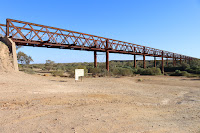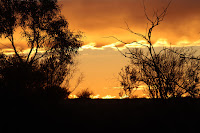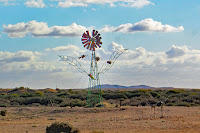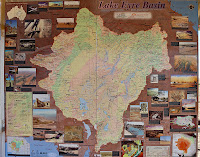Birdsville to Maree
25th May - Finally arrived in Birdsville and found a lovely free camp spot along the river. It had been a warm day at 32o C and there was a beautiful sunset on our first night.
 |
| Birdsville Sunset |
We planned to have a four night stopover here and completing another 'bucket list' experience - Birdsville and driving up Big Red - the highest sand dune in the Simpson Desert.
Our first day we visited the Wirrarri Information Centre and discovered some interesting short trips around Birdsville. There is also a lovely Art Gallery at the info centre displaying the work of local artists including traditional aboriginal artwork, contemporary art and photographs.
On our 2nd day, after a brief visit to the local medical centre and a short chat with the RFDS visiting medico for confirmation of a mild case of shingles, we headed 80km north for the day to visit the Carcoory Ruins and Bore. Some interesting sites along the way included a stand of ancient Waddi trees, a desert 'shoe rack' and a desert 'op shop'.
 |
| Shoe Rack |
 |
| Op Shop |
 |
Waddi Tree
|
The Waddi trees, one of only 3 stands remaining in Australia, are located 12km north of Birdsville on the Bedourie Rd.They are a rare tree with a population of 1,500,000 left in Australia. Up to 1,000 yrs old when dry they are almost impossible to drill and, so hard, they have been found to damage saws & axes.
Our next discovery was the Carcoory Ruins. This was one of the first properties that Sidney Kidman purchased in 1899.
 |
| Carcoory Ruins |
Classified by the National Trust, the remains of this homestead are situated close to a hot Artesian bore. The water being released from the bore is way above boiling point.
 |
| Artesian Pool |
 |
| Artesian Bore |
Returning to Birdsville we stopped into the local Bakery for obligatory camel pie followed by scones, cream and homemade jam - expensive but delish!
On our final day in Birdsville we explored a little more around town and finally visited the famous pub.
 |
| Birdsville Pub |
 |
| Us in the Pub |
Sadly we were a little disappointed with that visit. Obviously it would be more active and have more character during special events.
We also made the 30km drive out to Big Red to tick off another 'bucket list' activity.
After tackling Big Red confusingly we found Little Red more of a "challenge" to drive up due to the condition of the track. Obviously more people tackle this one therefore chopping up the track.
 |
| Billabong |
Returning to town we discovered a little gem at the edge of town. The Birdsville Billabong - a great place to go walking, kayaking, fishing, and of course swimming in the warmer months - not so much in 12o temps!
And our journey of discovery and learning continues as we prepare to drive the Birdsville Track (BT) and tick off ANOTHER 'bucket list' activity.
29th May - Today we entered 'new territory' as we began our journey south along the Birdsville Track, finally after 3 previous attempts during the past 3 years, which were cancelled due to the 'track' being closed due to floods. Surprisingly it was not as rough as we had expected. The vegetation and landscape varied from Gibber Plains to sandhills to green vegetated plains. We saw a variety of winter wildflowers and hundreds of budgerigars.
 |
| Wildflowers |
 |
| Tippipila |
Our first night free camp was at Tippipila Creek Bush Camp, a very cold and windy gibber plain - needless to say it was only a one nighter.
 |
| Us at Tippipila |
Day 2 we stopped at the Mungarannie Pub and read all about the rise of Sir Sidney Kidman, the property he owned and the lives of his workers. We had planned to stop overnight but changed our plans and continued onto a much more beautiful free camp at Cooper Creek. Along the way we passed through a 10km stretch of long and narrow sand dunes. This is where the Tirari and Strezlecki deserts meet. Also near here we discovered an old punt that was presented to settlers living north of the creek in 1949. It was used to ferry supplies and mail across the creek when it flooded.

|
| Spa |
 |
| M.V. Tom Brennan |
Our final stop along the Birdsville track was a real surprise. The Clayton Wetlands and spa is a real gem and a wonderful respite after travelling the dusty and sometimes rough Birdsville Track. Here we found a secluded and sheltered campsite amongst some shady trees.
 |
| Camp Site |
For a very low fee, $10 per night, there were flush toilets, hot shower and a very novel spa bath. The bath was an old water tank that could be filled with hot water from the artesian basin - and, yes, we stayed more than one night! Here we enjoyed the beauty of the star studded sky and Milky Way and the joy of seeing Zebra Finches bathing in the spa water, and watching Brolgas stroll past our campsite. It was definitely the perfect way to spend our last nights on the BT.
And, on the 6th day we arrived at the end of discovering the delightful, and not so delightful, aspects of the BT, arriving in Maree on 3rd June.
 |
| The end of the 'Track' |





















































